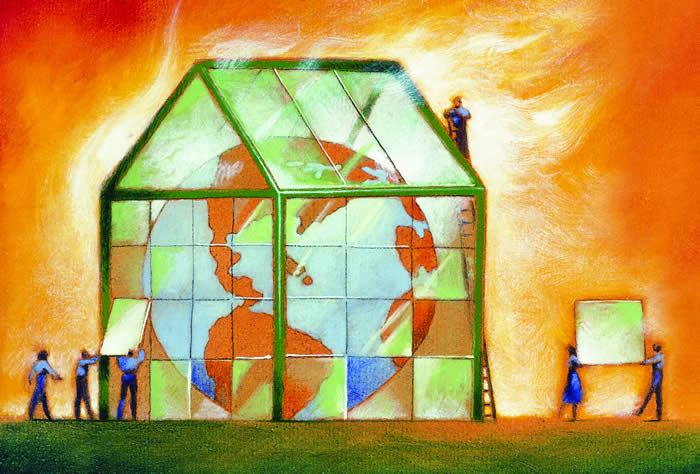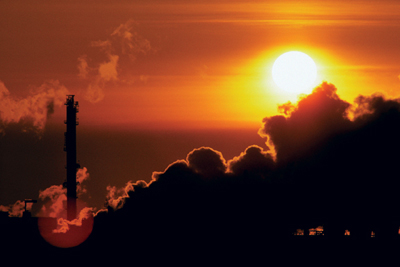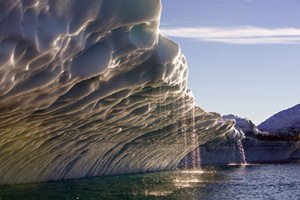
Blue and gold
... and going green
The effects of global warming could devastate New Jersey,
but it is not too late to save our state-and planet. Find
out what TCNJ is doing to fight the problem.
by Tony Marchetti '96, '02
If you watch the news on TV or read it online, there is a good chance you have been barraged by the ubiquitous images and footage of global warming: polar bears swimming across vast stretches of water in search of sea ice from which to hunt; glaciers that have stood for tens of thousands of years disappearing in decades; massive chunks of ice crashing into the sea; smokestacks breathing their sooty byproducts into the sky; coral reefs, once spectacular in their vivid array of colors, now bleached and dying.
You might also have been confronted with some of the statistics about global warming that are bandied about: The average global temperature has risen by 1.4° Fahrenheit (F) since the late 1800s; the 1980s and 1990s were the hottest decades in the last four centuries; 2006 was the hottest year on record in the continental United States.
What those images from distant lands and broad statistics about seemingly minuscule temperature changes might not impart is the very serious threat global warming poses to our corner of the world. However, recent reports issued by Environment New Jersey (ENJ) and the Union of Concerned Scientists (UCS) deliver precisely that message—and paint a bleak picture for New Jersey’s future
if global warming is not confronted head-on.
Greenhouse gasses
and the greenhouse effect
For those who might need a refresher course in (very) basic science, the greenhouse effect is the process by which the Earth traps the Sun’s heat in the atmosphere, thereby making the planet
a habitable temperature for humans. Greenhouse gasses (GHGs), such as carbon dioxide, methane, and nitrous oxide, are needed in the atmosphere
for this process to happen. The problem that has arisen is that an overabundance of these GHGs is now present in the atmosphere and is causing rapid, drastic changes to the Earth’s temperature and climate. “Atmospheric concentrations
of carbon dioxide, methane, and nitrous oxide have increased by over 30%, 145%, and 15%, respectively, since the late 19th century ” reported one Web
site (www.rggi.org).
The main cause of this overabundance of GHGs is the burning of fossil fuels by humans, say the majority of scientists. An everyday act as simple as driving your car emits carbon dioxide—the primary global warming pollutant—into the atmosphere. That heat-trapping gas will stay there for decades, possibly centuries. As one scientist put it, we are still breathing in the carbon dioxide emitted from the first Ford Model-T that rolled off the assembly line. Power plants burning fossil fuels release even more carbon dioxide into the air, as well as black carbons, which scientists now think could be as big a contributor to global warming as carbon dioxide. Landfills release methane gas. Our refrigerators and air conditioners release halocarbons, which are also a contributor to global warming. All of those GHGs are starting to have serious effects on the planet,
but the worst may be yet to come.

© Corbis
Global warming and New Jersey
“If global warming pollution across the world continues to rise, New Jersey will be a different place in 100 years, with an altered coastline, greater extremes of rainfall and drought, higher levels of smog in parts of the state, and shifts in the plant and animal species that call New Jersey home. ” That is the prognosis given in the ENJ report.
New Jersey is already getting hotter. Last calendar year was the second warmest on record in the state, and eight of the state ’s 12 warmest years have occurred since 1990. But those increases are a fraction of what could be in store. Global warming could raise temperatures well above historic levels in the state, making New Jersey 7° to 12°F warmer in the winter and 6°F to 14°F warmer in the summer. For a city like Newark, that could mean twice as many heat-related deaths by 2020 and five times as many by 2050, ENJ reported.
It's hard to argue
against something when
the facts support it.
Suburban areas could be affected too, because with the increased heat waves would come an increase in smog pollution and smog-related deaths. ENJ estimates these deaths could grow by more than six percent in Mercer, Somerset, Hunterdon, and Ocean counties. Poorer air quality due to global warming would also mean longer allergy seasons and increased risks for people with asthma.
The Jersey Shore could be one of the hardest hit regions. ENJ reports that sea levels could rise as much as 31 inches over the next century because of global warming, turning North Wildwood into an island and swallowing the Wildwood Boardwalk into the sea. Farther south, Cape May Beach could erode as much as 500 feet. Beach erosion and higher sea levels could also bring the proverbial 100-year flood to Atlantic City on an almost annual basis, according to the UCS report.
The Federal Emergency Management Agency estimates insurance premiums could increase 35 –60 percent if sea levels rose to those levels. The increase would be costly to most New Jersey residents, as 60 percent of them live in or around coastal regions. And with fewer beaches and regular flooding, the millions of tourists who flock to the Jersey Shore each year —generating $16 billion in tourism revenues in the process—will likely take their vacations, and wallets, elsewhere.
On the other side of the state, rising sea levels caused by global warming could jeopardize drinking water supplies, as the Delaware River salt line gets pushed upstream and pollutes the aquifers from which Camden draws its drinking water. To the North, rising sea levels would wreak havoc on the infrastructure in and around New York City. The Holland and Lincoln Tunnels, PATH and subway stations, and Newark Airport could see increased flooding that would “triple the amount of flood damage faced by the region in an average year,” ENJ reported.
Crops might also suffer, as increased temperatures could bring “greater heat stress…and increased pest populations,” according to the ENJ report. For example, cranberries, which have been harvested in the state since the days of the Lenni-Lenape Indians, might no longer grow here because of the warmer winters that global warming would bring.
This is but a brief summary of what could happen if we do not confront the issue of global warming. Yet while both reports indicate that some warming will occur no matter what, the good news from scientists is that it is not too late to stave off these worst-case scenarios. To do this, we must act now to reduce the harmful GHG emissions that are escalating the problem. The consensus view in the scientific community is that humans must reduce global warming emissions by at least 15 to 20 percent by 2020, and at least 80 percent by 2050.
TCNJ has gone green
TCNJ, along with other forward-thinking institutions across the nation, is heeding that call to action and taking it one step further. This past spring, President R. Barbara Gitenstein became a charter signatory
of the American College & University Presidents Climate Commitment (ACUPCC), pledging that TCNJ would immediately begin working toward neutralizing its global warming emissions. The commitment is the first collective effort by any major sector of society to set climate neutrality, not just reduced emissions, as a goal, according to ACUPCC representatives.
As part of the commitment, TCNJ
will begin to infuse its curriculum with research, discussions, and lessons in climate neutrality and sustainability, giving students the educational foundation they need to help society re-stabilize the world ’s climate. This initiative fits hand in hand with the College’s stated mission to be a national exemplar and to educate tomorrow’s leaders with the knowledge and tools necessary to sustain the communities in which they live.

© Corbis
This is a momentous undertaking for TCNJ, but also a major step toward preventing the worst effects of global warming from becoming reality. “Our environmental consciousness and pursuit of energy efficiency has been ongoing for many years, but we are committed to doing more as we move forward and serving as a leader in this critical endeavor, ” said President Gitenstein.
A committee of students, staff, and faculty is guiding the implementation process at the College. The committee ’s first matter of business is to inventory the College’s GHG emissions. That entails cataloging such things as how much oil, electricity, and natural gas the College consumes over the course of a year and how much fuel college vehicles use, said Lori Winyard, director of energy and central utilities and a member of the ACUPCC implementation committee.
It also means tracking down data on emissions caused by faculty, staff, and students in their daily commutes, as well as emissions resulting from work-related air travel by college officials.
Once collected, these figures will be plugged into an online campus carbon calculator to determine the College ’s carbon footprint. The College must report that footprint information next year to ACUPCC representatives, but will also use it to determine how soon TCNJ can neutralize its heat-trapping emissions, said Michael Horst, assistant professor of civil engineering and committee cochair.
...alarmingly, of all developed countries in the world, the United States is the only on that has not 100 percent accepted this.
The committee is also investigating short-term strategies to help the College immediately begin reducing its carbon footprint. One such strategy is encouraging the use of public transportation by campus constituents, Horst said. Another is a proposal “that all equipment purchased by the College be Energy Star compliant,” noted Curt Heuring, vice president for facilities management, construction, and campus safety and committee co-chair. The committee “also is looking at establishing a policy that
all new buildings be designed to a Leadership in Energy and Environmental Design (LEED) silver standard, an industry benchmark, ” Heuring added.
The committee is further examining waste minimization initiatives, primarily in the form of recycling. “We are discussing the steps that TCNJ already takes to recycle, as well as what measures we can implement to encourage more recycling throughout the campus community, ” Horst said. “We are also looking into recycling of food waste products—for example, collecting discarded food products and selling the products to local farmers who might be able to use them as stock feed. ”
While some of these efforts could mean added costs early in the implementation process, over time, they will ultimately save the College money. For instance, while an energy-efficient air-conditioning unit might cost more than a non-efficient unit, the reduced energy costs for running the unit will eventually cover the initial cost difference and then turn into savings over time. The committee is also working with the development office staff to find financial incentives and grants for purchasing these “green technologies,” which could help offset the higher upfront costs and make the investment that much more attractive, Winyard said.
Within two years, the College must issue a report that states the date by which TCNJ will be climate neutral and its interim milestones for achieving that goal. The report will also describe the mechanisms TCNJ will use to track its progress along the way, and include the College ’s plan to make climate neutrality and sustainability part of the curriculum.
Although the report is still in the early stages, Horst said he already incorporates global warming lessons into his own classes, teaching students what GHGs are and why they are a problem. “I also spend a good amount of time discussing the facts that support that global warming is a problem, because, alarmingly, of all the developed countries in the world, the United States is the only one that has not 100 percent accepted this. ” He gets a couple of students every year who profess skepticism about the dangers of global warming when they begin his class, but has yet to fail to convince any of them of the reality and severity of the problem by the end of the semester. “It’s hard to argue against something when the facts support it.”
Confronting global warming will likely cause us to question and re-evaluate many of the actions we consider typical, and preventing it could prove to be the defining challenge of this generation.
This new initiative to bring sustainability and climate neutrality into the curriculum is taking hold in other disciplines, as well. Working with the School of Nursing, Health, and Exercise Science and the School of Science, the School of Culture and Society has already started to discuss “how to educate students to be citizens in a very challenging world, where they’ll be seeing the effects of climate change,” said Dean Susan Albertine. She envisions exciting opportunities for cross-curricular work because of the initiative and hopes to see the Liberal Learning classes infused with a new way of thinking about health and the environment. She said faculty members have echoed that sentiment.
“We’re thinking about the students’ futures,” Albertine said. “They need to be able to think socially. They need to be able to interpret. They need to be able to use statistical thinking. They need to be able to solve problems by writing. A lot of the interpretive skills that come with liberal education are helpful to citizens as they address a changing world. ”
This is not a new set of skills that will need to be taught, just “a new focus and a renewed commitment to interdisciplinary work that emphasizes the health of communities through work on the environment,” Albertine said. And while she is excited by the opportunities this initiative will give the faculty to think creatively within the curriculum, she also realizes that it is something that must be done now.
“I don’t see any reason to think that things are going to suddenly go back to the way they were in the pre-industrial world, ” Albertine said. “It’s not going to happen, and we’re going to have to get ready for some big changes, and do what we can to minimize the impact.
If we don’t educate our students well, they’re going to grow up to be citizens who don’t know how to deal with the world ahead.”
The effects of global warming on New Jersey’s ecosystem and economic stability could prove catastrophic, altering the state’s character and physical characteristics and ruining the quality of life for its inhabitants. Worse still, these changes are not thousands of years off: they could happen within our lifetime and our children ’s lifetimes, as the ENJ and UCS reports indicate. Confronting global warming will likely cause us to question and re-evaluate many of the actions we consider typical, and preventing it could prove to be the defining challenge of this generation. TCNJ ’s diversity of scholars and role as a national exemplar uniquely position it to help answer those questions and take up the challenge. In the process, it might just save a few polar bears, too.
 © Corbis © Corbis
|






 © Corbis
© Corbis